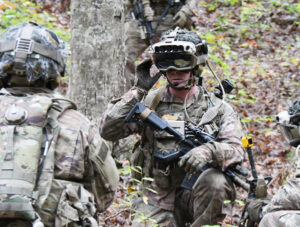House appropriators have cut $400 million for Army procurement of the Integrated Visual Augmentation System (IVAS) in its version of the fiscal year 2023 defense spending bill, withholding the funds while the service waits to conclude its operational evaluation of the new headset.
“With questions still outstanding regarding the production viability of IVAS, the committee cannot recommend additional procurement funding until after a full review of the results of [initial operational test and evaluation] (IOT&E),” the lawmakers write in a report accompanying the defense spending bill, released a day ahead of the full House Appropriations Committee’s consideration of the legislation.

The House Appropriations Subcommittee on Defense released the $761.7 billion spending bill last week, with the full panel likely to consider a bevy of amendments during Wednesday’s markup (Defense Daily, June 14).
The bill includes $99.5 million for the Army’s night vision devices procurement account, a $325 million decrease from the $424.3 million included in the budget request.
The adjustment comes from the $400 million cut to procurement of the Microsoft [MSFT]-built IVAS headset and a $75 million increase for the Army’s Enhanced Night Vision Goggles-Binocular (ENVG-B), manufactured by L3Harris [LHX] and Elbit Systems of America.
The Army’s FY ‘23 budget request had called for $400 million to cover procurement of just over 7,000 IVAS headsets and $62 million for research and development of the 1.2 version of the system (Defense Daily, March 29).
“Congress has appropriated over $1 billion for IVAS procurement and has yet to receive a production quality system,” the House appropriators wrote in the bill report.
House appropriators note that IOT&E for IVAS to inform a full-rate production decision is ongoing right now after the process was pushed back from late FY ‘21 “due to a variety of software and hardware concerns.”
“The committee directs the [Program Executive Office]-Soldier to brief the House and Senate Appropriations Committees on the results of IOT&E as soon as practicable,” lawmakers write in the bill report.
Army Secretary Christine Wormuth told the Senate Appropriations Defense Subcommittee last month that the Army’s evaluation of IVAS coming out of IOT&E will determine whether the service moves forward with the program (Defense Daily, May 10).
“I think our sense is that the testing is going to prove that the system and some of the kinks that we’ve been working on with Microsoft are going to be resolved. But if we were surprised by the test results, we would certainly want to take that into account. But right now the trajectory that I think I see in front of us is that we are going to move forward with fielding IVAS,” Wormuth said at the time.
Wormuth told the Senate Armed Services Committee in early May that senior Army officials “did not fully agree” with the findings in a recent Pentagon inspector general’s report that stated the Army “did not define minimum user acceptance levels” for the IVAS program and risk potentially ‘wasting’ $22 billion if soldiers don’t want to use the new headset. (Defense Daily, May 5).
Lawmakers have already placed $350 million of the total $405.1 million for IVAS procurement in FY ‘22 on hold until the completion of IVAS’ initial operational test and evaluation and after Army officials brief Congress on the status of the program (Defense Daily, March 14).
The House Armed Services Committee’s mark of the FY ‘23 National Defense Authorization Act supports $524.3 million for the Army’s night vision devices, including a $100 million boost for ENVG-B and no cut to IVAS.